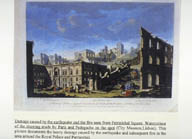
|
Image-KZ100
Ruins of Praca de Patriarcal. The ruined facade of the Patriarcal is on the left, its central axis marked by one door flanked by columns. (Colored engraving, Paris, 1757)
|
|
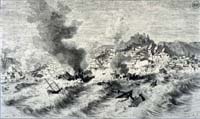
|
Image-KZ101
View of Lisbon from south to north. Rough waters on Tagus River, the city is devastated and fire has broken out. See KZ893 for color version. (Engraving, Paris, 1863)
|
|
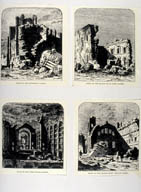
|
Image-KZ102
Four views of important buildings in Lisbon: The Cathedral, Opera House, churches of S. Nicolau and S. Paolo. (Wood engraving, book illustration) (Lisbon, Portugal)
|
|
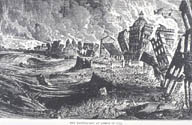
|
Image-KZ103
Dramatic depiction of Lisbon along the bank of the Tagus River from east to west: houses exploding into fire, turbulent water, sinking ship, people fleeing. (Wood engraving, 1887)
|
|
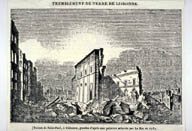
|
Image-KZ104
Ruins of Igreja de S. Paulo (Church of St. Paul), Lisbon. (Wood engraving, Paris, 1863??)
|
|
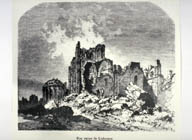
|
Image-KZ105
Romantic view of the ruins of the Lisbon Cathedral. (Steel engraving, Paris, ca. 1866)
|
|
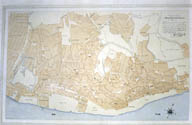
|
Image-KZ107
City plan of Lisbon as it looked in 1650, before the earthquake.
|
|
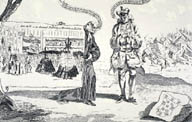
|
Image-KZ108
British satirical illustration. The Portuguese King asks a Protestant clergyman how to avoid future manifestations of divine displeasure, as evidenced by the earthquake. Damaged Lisbon in the right background. (Lisbon, Portugal)
|
|
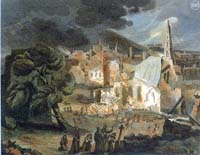
|
Image-KZ109
People escaping from ruined Lisbon, some saving their property, some praying. Ruined town in middle. (Colored print, England, 1817)
|
|
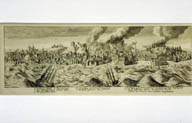
|
Image-KZ110
View of Lisbon from south across Tagus River. Rough waters, fire, earthquake damage exaggerated. (Copper engraving. Germany?, late 18th c.?) (Lisbon, Portugal)
|
|
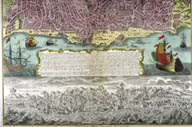
|
Image-KZ111
Upper register is colored map of Lisbon before the earthquake. Lower register, in black and white, depicts Lisbon in flames shortly after the earthquake. Includes legend. Insert is bilingual (German & Latin) text. (Hand-colored copper engraving, Germany, 18th c.?) (Lisbon, Portugal)
|
|
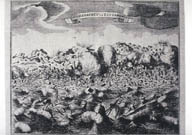
|
Image-KZ112
'Das erdbeben zu Lissabon.' Imaginary view of Lisbon after the earthquake as seen from the Tagus River. (Engraving, Germany?, latter half 18th c.) (Lisbon, Portugal)
|
|

|
Image-KZ113
Lisbon seen from the east during the earthquake. Exaggerated fire and damage effects. People fleeing in foreground. (Copper engraving, Netherlands, 1756.) (Lisbon, Portugal)
|
|
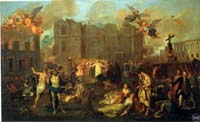
|
Image-KZ114
The scene is the Praca de Santa Catarina on high ground close to the Tagus River in southwest Lisbon. The church is severely damaged. Dispossessed and injured people congregate in front of it. (Oil painting, Portugal, 1760) (Lisbon, Portugal)
|
|
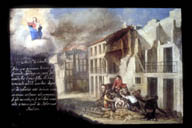
|
Image-KZ115
Attempt to rescue child from rubble. Buildings damaged by earthquake, fire in the background. Text describes the rescue. Ex-voto painting to Our Lady of the Star, Portugal, 18th c.
|
|
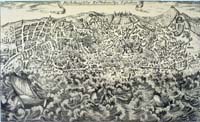
|
Image-KZ117
Fanciful map of Lisbon: view from south across the river. (Copper engraving, Germany?, after 1755). Kozak suggests this map probably derived from G. Braun's composition in his Civitates Orbis Terrarum (1572 to 1617). [This Braun image is courtesy of Professor Gerard Passannante, University of Maryland].
|
|
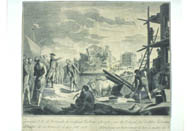
|
Image-KZ118
Reconstruction work in Lisbon being inspected by Joseph I, King of Portugal. Unknown building being rebuilt on right. (Copper engraving, Portugal, after 1755) (Lisbon, Portugal)
|
|
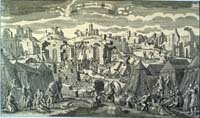
|
Image-KZ119
Lisbon a few days after the earthquake. Camping outside the damaged town, executions of robbers and looters. (Copper engraving, Germany, 1755) (Lisbon, Portugal)
|
|
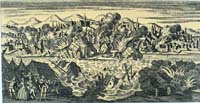
|
Image-KZ120
Exaggerated view of Lisbon from the southern bank of the Tagus River. Refugees from the city are camping in the foreground. (Copper engraving, Germany, late 18th c.?) (Lisbon, Portugal)
|
|
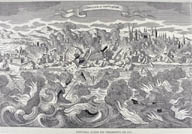
|
Image-KZ121
Dramatic and somewhat exaggerated view of Lisbon from across the Tagus River. Possibly based on description or earlier depictions (Copper engraving, Germany, 18th c.?) (Lisbon, Portugal)
|
|
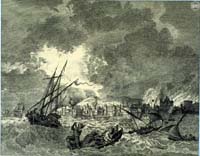
|
Image-KZ122
Refugees escaping Lisbon by boat. (Copper engraving, Netherlands, 18th c.?) (Lisbon, Portugal)
|
|
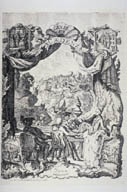
|
Image-KZ123
Lisbon in background, seen from across the river. (Copper engraving, 18th c.) (Lisbon, Portugal)
|
|

|
Image-KZ124
Lisbon after the earthquake, seen across the Tagus River. Fires burn in the city. (Copper engraving, Germany, 18th c.?) (Lisbon, Portugal)
|
|
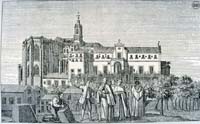
|
Image-KZ125
Convento de Carmo (Carmelite church) in Lisbon before it was destroyed by the earthquake. (Copper engraving, Portugal, 18th c.) Compare to modern photo in KZ135.
|
|
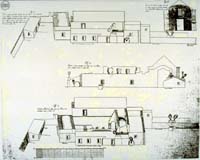
|
Image-KZ127
Ruins of the Trindade Convent. (Drawing, Portugal, 18th c.) (Lagos, Portugal)
|
|
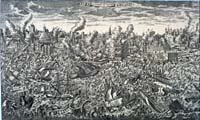
|
Image-KZ128
View of Lisbon with very rough water in the foreground (probably the Tagus River), caused by the earthquake. (Copper engraving, France,) (Lisbon, Portugal)
|
|
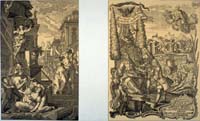
|
Image-KZ129
Two images of disaster relief in Lisbon. On the left, a woman is rescued with ladder and a group of citizens provide first aid (engraving after KZ67). On the right, a distressed woman (possibly an allegorical figure ) is being comforted, with the devastated city in background. (Lisbon, Portugal)
|
|
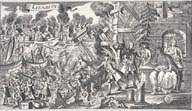
|
Image-KZ130
View of Lisbon from across the river: harbor, damaged buildings, sinking ships. (Copper engraving, Germany, 18th c.) (Lisbon, Portugal)
|
|
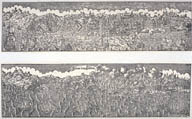
|
Image-KZ131
Lisbon before (upper image) and after (lower image) the earthquake, showing the city in flames. View from south to north, across the river. Derived from earlier images. (Copper engraving, Germany, 18th c.?) (Lisbon, Portugal)
|
|
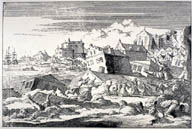
|
Image-KZ132
Dramatic scene of Lisbon with buildings tilted and fallen, people falling into fissures, etc. (Copper engraving, 18th c.?) (Lisbon, Portugal)
|
|

|
Image-KZ133
Pre-earthquake view of Lisbon from south across Tagus River (Copper engraving, France, before 1755) (Lisbon, Portugal)
|
|
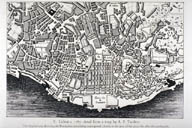
|
Image-KZ134
Detail of map of Lisbon showing rebuilt plan on rectangular grid. Section of town on alluvial soil had the most damage. Town rebuilt by Duke de Pombal. (Copper engraving, France, 1785)
|
|

|
Image-KZ135
Photograph of the ruined Convento de Carmo (Carmelite Church), destroyed in 1755 by the earthquake. 15th century gothic columns and rib vaults shown. (Color photo, 1993). Compare to pre-earthquake engraving in KZ125. (Lisbon, Portugal)
|
|
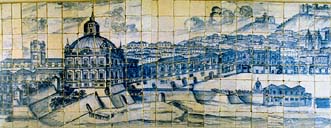
|
Image-KZ136
Central Lisbon before the earthquake. Center: Royal Palace Square and Cathedral; left: Royal Palace and Clock tower. At bottom, the Castle and Graca Convent. Clock tower closest to river. (Detail of colored tile panel, Portugal, early 18th c.) (Lisbon, Portugal)
|
|

|
Image-KZ138
Carlos Mardel's design for the reconstruction of the Terreiro de Paco (Royal Palace Square). (Copper engraving, colored, Portugal, after 1755) (Lisbon, Portugal)
|
|

|
Image-KZ139
Map shows extent of shock felt in Europe. Background shows exaggerated damage, stones falling from tops of hills and other unrealistic phenomena. (Copper engraving, Germany, 1756) (Lisbon, Portugal)
|
|

|
Image-KZ140
Upper panel shows Lisbon before the earthquake. Lower left panel shows damaged buildings and refugees in tents. Lower right panel is town of Meknes in Morrocco, also affected by the earthquake. (Copper engraving) (Lisbon, Portugal and Meknes, Morocco)
|
|

|
Image-KZ141
Death and destruction in Lisbon, dramatically exaggerated. (Woodcut, Switzerland, 1756) (Lisbon, Portugal)
|
|

|
Image-KZ142
The Lisbon earthquake as depicted in a Czech broadside. (Woodcut, Bohemia, 1755)
|
|
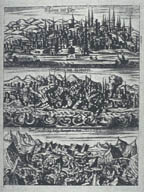
|
Image-KZ143
Multiple images: Top: stylized representation of Lisbon before the earthquake. Center: Lisbon after the quake. Bottom: earthquake effects in Meknes, Morocco. (Lisbon, Portugal and Meknes, Morocco)
|
|

|
Image-KZ144
Stylized representation of structural damage in Lisbon and of people taking refuge in rather elegant tents. Text describes the earthquake and compares it to the earlier 1531 earthquake. Reworking of KZ119. (Copper engraving, Germany, after 1755).
|
|
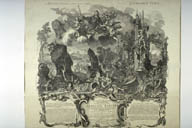
|
Image-KZ145
This image is from a Czech university thesis (Tepla monastery) from 1765 in which the physics of the earth is discussed. The image was inspired by the 1755 Lisbon earthquake. St. Alexius, patron saint of earthquakes, floats across the sky. (Copper engraving, Bohemia, 1765) (Lisbon, Portugal)
|
|

|
Image-KZ146
Boat on Haarlemer-Meer in the Netherlands capsizes due to effects of the Lisbon earthquake. (Copper engraving, Netherlands, 18th c.?)
|
|

|
Image-KZ147
Imaginary depiction of the Earth showing interconnected corridors of fire. Volcano at another part of the Earth supposedly caused the earthquake in Lisbon.
|
|

|
Image-KZ148
Imaginary depiction of the Lisbon earthquake and the inhabitants' response. Caption in Czech reads 'In 10 minutes, 40,000 people were buried and died in the quake'. (Copper engraving, Pilsen, Bohemia, 19th c.) (Lisbon, Portugal)
|
|
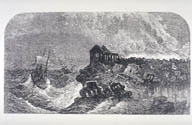
|
Image-KZ149
Imaginary illustration from the 1840's shows that earthquake had not been forgotten even after 90 years. (Newspaper illustration, London, ca.1840) (Lisbon, Portugal)
|
|
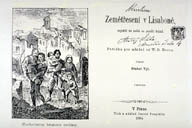
|
Image-KZ150
'Rescue of the Duke's family' in Lisbon after the earthquake. (Frontispiece copper engraving from Czech book, l864) (Lisbon, Portugal)
|
|
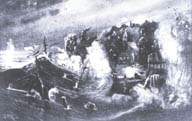
|
Image-KZ151
Illustration from religious book. Natural disasters are interpreted as punishment from God. (Lisbon, Portugal)
|
|
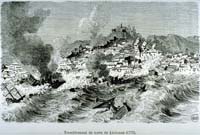
|
Image-KZ32
City of Lisbon damaged by earthquake and subsequent fire. (Wood engraving, Paris, 1882)
|
|
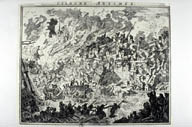
|
Image-KZ64
'Lisbone abysmee.' View of Lisbon from south to north including the Tagus River with refugee-laden boats sinking in rough water. On left, a fanciful tsunami engulfs the town. Numbering of the buildings implies a description which is now lost. Houses on extreme left undamaged. (Copper engraving, France, 18th c.) (Lisbon, Portugal)
|
|
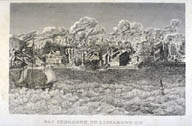
|
Image-KZ65
Fire and earthquake damage in Lisbon. One ship sank in rough waters in the Tagus River. Town seen from south. (Steel engraving, Germany, 1820?) (Lisbon, Portugal)
|
|
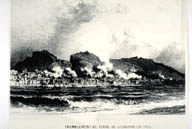
|
Image-KZ66
Town seen from south of Tagus River. Represents Lisbon 2-3 days after the earthquake. Shows damage to town. Fires still burn but the water is calmer. Background hills are not accurate. Low resolution of photo prevents identifying details. Position of castle indicates image is flipped left to right. (Lithograph, Paris, 1866?) (Lisbon, Portugal)
|
|
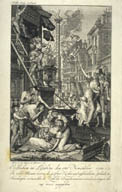
|
Image-KZ67
Rescue scene in Lisbon. Women and children being rescued with ladders. In the background, one house is on fire, one in the midst of collapse, the house on the right appears undamaged. One of the few images showing disaster relief. (Copper engraving, Vienna, 1793). (Lisbon, Portugal)
|
|
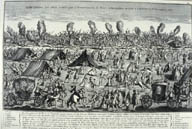
|
Image-KZ68
Lisbon and suburbs seen from north. Description and legend describe damaged town structures. In the background, the town is hardly recognizable. In foreground, refugees camp out in tents. (Copper engraving, Paris, 1792). (Lisbon, Portugal)
|
|
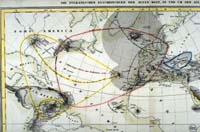
|
Image-KZ689
Map of areas where the effects of the 1755 Lisbon earthquake were observed and recorded. (Pan-Atlantic region)
|
|
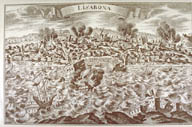
|
Image-KZ69
View of Lisbon from the south across the Tagus. The ruined Almada Fortress is in the immediate foreground, then the rough waters of the river, with ships. The city is in the middle ground with some buildings engulfed by water. In the distance, refugee tents. (Copper engraving, Augsburg, 1792) (Lisbon, Portugal)
|
|
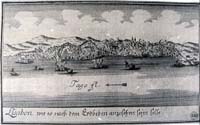
|
Image-KZ692
Damaged town seen from south over Tagus river. Buildings on fire. Ships on fire or sinking. (Copper engraving) (Lisbon, Portugal)
|
|

|
Image-KZ694
Lisbon damaged by earthquake. Part of city on fire. Ships rocked by rough water. (Lisbon, Portugal)
|
|
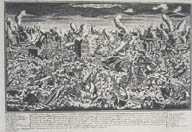
|
Image-KZ70
Lisbon seen from south over rough waters of Tagus River. Ships staggering, houses collapsing, town on fire. (Copper engraving, France, 18th c.?) (Lisbon, Portugal)
|
|
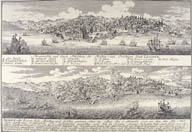
|
Image-KZ71
Lisbon before (upper image) and after (lower image) the earthquake, view from south. Legend A through Q on upper image indicates specific buildings. (Copper engraving, Zurich, 1756) (Lisbon, Portugal)
|
|
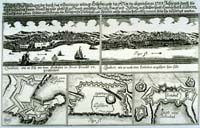
|
Image-KZ72
Views and maps of Lisbon before and after the earthquake. (Copper engraving, Augsburg, Germany, 1755 or -6) (Lisbon, Portugal)
|
|
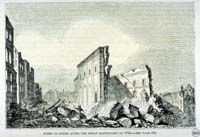
|
Image-KZ723
Collapsed church of St. Paul and other buildings destroyed by the Lisbon earthquake.
|
|

|
Image-KZ73
Royal Palace at Lisbon before the earthquake. (Copper engraving) (Lisbon, Portugal)
|
|
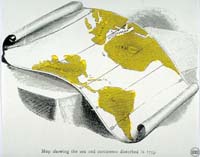
|
Image-KZ735
World map purporting to show how widely felt the 1755 Lisbon earthquake was. (Book illustration)
|
|

|
Image-KZ75
Ribeira Palace after the earthquake. The roof has collapsed but the main structure does not appear to have sustained much damage. (Copper engraving) (Lisbon, Portugal)
|
|

|
Image-KZ76
Ribeira Palace seen from northeast after repairs. Ground floor has been strengthened. Roof and cupola replaced. (Engraving) (Lisbon, Portugal)
|
|
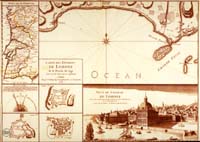
|
Image-KZ765
Map and view of Lisbon before the earthquake. (Lisbon, Portugal)
|
|
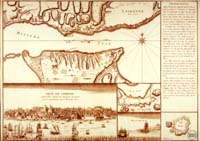
|
Image-KZ766
Map and view of Lisbon before the earthquake. (Lisbon, Portugal)
|
|

|
Image-KZ78
Repairs and new construction after the Lisbon earthquake. (Copper engraving, 18th c.) (Lisbon, Portugal)
|
|
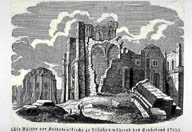
|
Image-KZ79
Ruins of The Cathedral and the Basilica de Santa Maria, Lisbon. Simplified copy of Le Bas engraving. (Wood engraving, Germany, 1836) (Lisbon, Portugal)
|
|
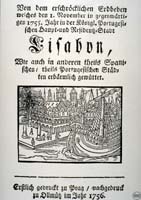
|
Image-KZ821
View of the port of Lisbon before the earthquake. (Lisbon, Portugal)
|
|
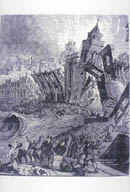
|
Image-KZ82A
Tsunami (or seiche) struck the north bank of the Tagus River, completing the damage to Lisbon begun by the earthquake. Detail of KZ82. (Wood engraving?, 18th c?)
|
|
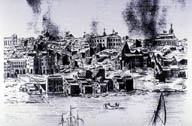
|
Image-KZ83
Port of Lisbon seen from south, from the Tagus River. Town is heavily damaged and fire has broken out. (Copper engraving, 18th c.?) (Lisbon, Portugal)
|
|
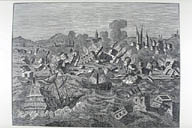
|
Image-KZ84
Somewhat fanciful depiction of Lisbon, after earlier prints. View towards harbor and city from the south, across the river. (Copper engraving, Prague, 1820-22) (Lisbon, Portugal)
|
|
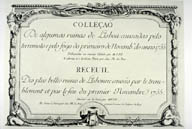
|
Image-KZ85
Title page for 'Collecao de algunas ruinas de Lisbon causados pelo terramoto e pelo togodo primeiro de Novemb. Do anno 1755.' The authors, Pedegache and Paris, made sketches of damage shortly after the earthquake. The images are high quality and precise, approaching the verity of photographs. (Paris and London, 1757)
|
|
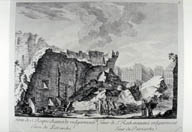
|
Image-KZ86
Tower of S. Roque collapsed in Lisbon, Portugal. Buildings in background undamaged. The "Tower" was one of the 77 towers of the wall built 1373-1375, during the reign of Ferdinand I to protect Lisbon from Castilian invaders. (Wood engraving, 1757)
|
|
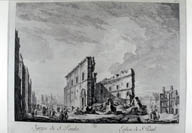
|
Image-KZ87
Igreja de S. Paulo (Church of St. Paul), Lisbon. Buildings at left shored up by wooden poles. (Copper engraving, 1757)
|
|
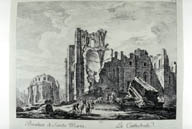
|
Image-KZ88
Ruins of the Cathedral and the Basilica of Santa Maria. (Copper engraving, caption in French and Portuguese; no.5 in the Le Bas series, Paris, 1757) (Lisbon, Portugal)
|
|
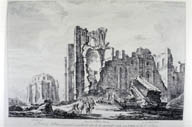
|
Image-KZ89
Ruins of the Cathedral and the Basilica de Santa Maria. Flowers and trees already growing from ruins. (Copper engraving, English version of French print, London?, 1757. See also KZ88)
|
|

|
Image-KZ893
View of Lisbon from south to north. Rough waters on Tagus River, the city is devastated and fire has broken out. (Book illustration based on original engraving produced in Paris, 1863).
|
|
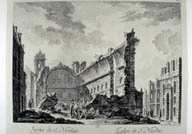
|
Image-KZ90
Igreja de S. Nicolau (Church of St. Nicholas) was one of the oldest churches in Lisbon. Destroyed by earthquake and fire.
|
|
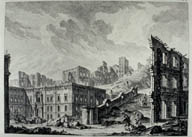
|
Image-KZ91
Ruins of Praca de Patriarcal (Patriarcal Sq.) (Copper engraving, Paris, 1757)
|
|

|
Image-KZ914
Ruins of the Church of St. Anthony in Lisbon. SEE ALSO KZ915. (Lisbon, Portugal)
|
|
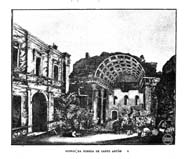
|
Image-KZ915
Ruins of the Church of St. Anthony in Lisbon. SEE ALSO KZ914. (Lisbon, Portugal)
|
|
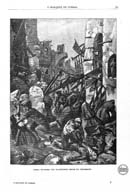
|
Image-KZ916
Citizens of Lisbon attacked by "evil-doers" after the earthquake. (Lisbon, Portugal)
|
|
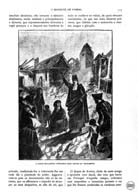
|
Image-KZ917
Preaching to the survivors. (Lisbon, Portugal)
|
|
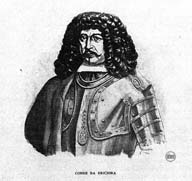
|
Image-KZ918
Portrait of the Count of Ericeira. The Marquis of Pombal was the author of a eulogy of the fifth count of Ericeira (Luís Carlos Inácio Xavier de Meneses (1689-1742)), in 1742.
|
|
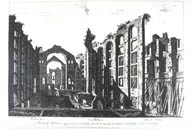
|
Image-KZ92
Ruins of Opera House, Lisbon. Buildings on right shored up with tree trunks. (Copper engraving, Paris?, 1757) Caption in English. (Lisbon, Portugal)
|
|
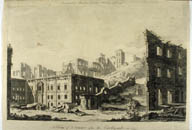
|
Image-KZ93
Ruins of Praca de Patriarcal (Patriarcal Sq.) Caption in English. (Copper engraving, Paris, 1757) (Lisbon, Portugal)
|
|
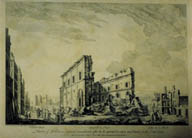
|
Image-KZ94
Igreja de Sao Paulo (St. Paul's Church) in ruins. Facade of the church collapsed, blocking the main door. More than 60 people inside the church died. (Copper engraving, Paris?, 1757)
|
|
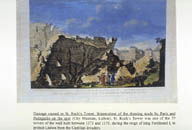
|
Image-KZ95
Damage to Tower of S. Roque. This tower was one of the 77 towers of a wall built between 1373 and 1375, during the reign of Ferdinand I, to protect Lisbon from Castilian invaders. (Colored engraving, Paris, 1757)
|
|

|
Image-KZ96
Igreja de S. Paolo (St. Paul's Church) The façade of the church collapsed, blocking the main door. More than 60 people were killed in the church by the earthquake and fire. (Colored engraving, Paris, 1757)
|
|

|
Image-KZ97
Two towers of the Lisbon Cathedral fell in the earthquake. The destruction was completed by fire. The building in left background may be ruins of church of S. Antonio. (Colored engraving, Paris, 1757)
|
|
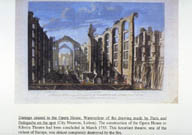
|
Image-KZ98
The luxurious Lisbon Opera House, or Opera do Tejo, had just been completed in March 1755. It was almost completely destroyed by the fire following the earthquake. (Colored engraving, Paris, 1757)
|
|
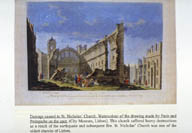
|
Image-KZ99
Igreja de S. Nicolau (Church of St. Nicholas), one of the oldest churches in Lisbon was destroyed by the earthquake and subsequent fire. (Colored engraving, Paris, 1757)
|
|

|
Image-KZA32
Imaginary street scene during Lisbon earthquake. (Book illustration)
|
|

|
Image-KZA33
Imaginary street scene during Lisbon earthquake. (Book illustration)
|
|

































































































